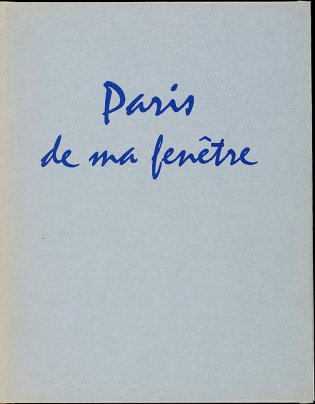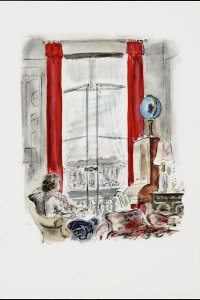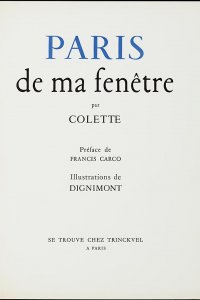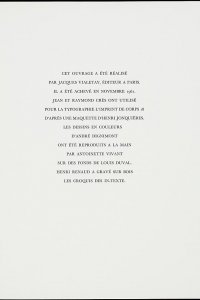Paris de ma fenêtre
Year: 1961
Author: Colette (1873 - 1954)
Artist: André Dignimont (1891 - 1965)
Publisher: Trinckvel
Famous window
Of all the many tributes to her, one undoubtedly pleased her enormously: her membership and later her presidency of the Académie Goncourt. She did face one more scandal at the very end: the church refused to participate in the national funeral of this heathen 'reine de la terre'. She probably wouldn't have cared. On 7 August 1954 she was paid the last honours on the square where she had lived: Port-Royal. The collection Paris de ma fenêtre- Paris from my window - refers to this square and its direct surroundings; 'The Louvre and its flower beds, Rivoli and its arcades'. The pieces date to the beginning of World War II. Colette wrote that most bouquinistes had become a kind of reading libraries for young people who couldn’t afford to purchase books and who 'read fifty pages today, the same number tomorrow, and the rest the day after'.
The window of Colette's apartment was the frame for several famous photographs of the older Colette. This window also found a place in this book, viewed both from the inside - as on the frontispiece - and from the outside. The illustrations are lithographs based on aquarelles by the industrious illustrator André Dignimont. In his prints, Colette sits like a small figure in her elegant interior. The book also contains black-and-white illustrations: they were printed on the basis of wood-engravings by Henri Renaud that were based on Dignimont's sketches. The book was printed by Jean and Raymond Crès in November 1961 after a design by Henri Jonquières, who was also active as a publisher.
These deliberations of Colette's are not considered part of her best work, but they are the work of a mature author, who in this case was addressing her fellow women. The first edition appeared in 1942, and in 1944 a revised edition appeared in Switzerland. The edition of Trinckvel is the seventh edition and the third illustrated edition. Clément Serveau and Louis Touchagues preceded Dignimont in bringing to life the intimate scenes with interiors, flowers and animals.
Bibliographical description
Description: Paris de ma fenêtre / par Colette ; préf. de Francis Carco ; ill. de Dignimont. - Paris : Trinckvel, 1961. - 202 p. : ill. ; 35 cm
Printer: Jean en Raymond Crès (text) Antoinette Vivant (illustrations)
Edition: 500 copies
This copy: Number 271 of 500 on vélin blanc
Bibliography: In liefde verzameld-193; Monod 3032
Shelfmark: KW Koopm A 337
References
- Colette, Oeuvres, IV. Paris, Gallimard, 2001. (Bibliothèque de la Pléiade, 481)
- Nicole Ferrier-Caverivière, Colette l'authentique. Paris, Presses Universitaires de France, 1997
- Hortense Dufour, Colette la vagabonde assise. Monaco, Rocher 2000



![Illustratie door André Dignimont (p. [25])](/sites/default/files/styles/galerie/public/images/paris-de-ma-fenetre-p25.jpg?h=94488d80&itok=F24aot89)

![Illustratie door André Dignimont (p. [73])](/sites/default/files/styles/galerie/public/images/paris-de-ma-fenetre-p73.jpg?h=09f21e1b&itok=8mZ7recV)
